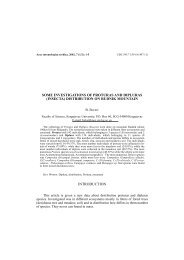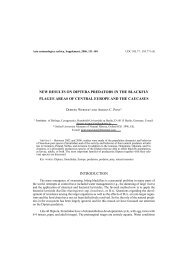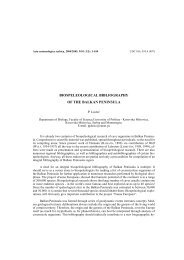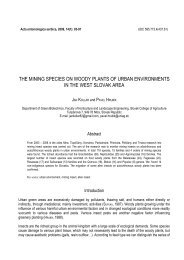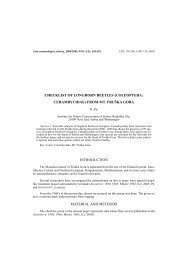Ćetković, A., Mokrousov, M., Plećaš, M., Bogusch, P., Antić, D ...
Ćetković, A., Mokrousov, M., Plećaš, M., Bogusch, P., Antić, D ...
Ćetković, A., Mokrousov, M., Plećaš, M., Bogusch, P., Antić, D ...
You also want an ePaper? Increase the reach of your titles
YUMPU automatically turns print PDFs into web optimized ePapers that Google loves.
108 A. ĆETKOVIĆ et al.<br />
we reared adults (both males and females) in August of the same year. Therefore, the period of adult activity<br />
seems to be distinctly longer in southeastern than in central Europe (as expected), and at least two<br />
generations certainly develop in northern Serbia.<br />
The great majority of S. deforme specimens from central European Russia, published herewith, were<br />
collected between late June and early August, just two records being from the first half of June, and the other<br />
two from the second half of August. Hence, only one generation may develop in these areas, the most<br />
northerly situated in the whole range of the subgenus Hensenia.<br />
Note on invasiveness<br />
Like other introduced Sphecidae, both Hensenia species were automatically considered as invasive in<br />
Europe (GEPP, 2003; BITSCH & BARBIER, 2006; DAISIE, 2008a, 2008b, 2009; RASPLUS, 2010; RASPLUS et al.,<br />
2010; CABI, 2011a, 2011b; etc), which might be arguable depending on the concept of the term ‘invasive’ as<br />
applied by various authors (i.e. RICHARDSON et al., 2000; FALK-PETERSEN et al., 2006; PYŠEK et al., 2009; vs.<br />
MCNEELY et al., 2001; DAVIS, 2009; SHINE et al., 2010; etc.); hence their (eventual) status of invasiveness,<br />
and in particular the potentially adverse ecological impacts thereof, are yet to be documented and evaluated<br />
(cf. ĆETKOVIĆ et al., unpublished).<br />
Acknowledgements<br />
We are grateful to S. ĐUKIĆ, D. PAVIĆEVIĆ, M. PAUNOVIĆ, S. OGNJENOVIĆ, D. SAVIĆ, T. MILIVOJEVIĆ, I. VASILIĆ,<br />
V. MILUTINOVIĆ, S. POPOVIĆ, M. BOŠKOVIĆ, S. NEDOVIĆ, J. PLAVŠIĆ, A. TOMIĆ, S. ČKRKIĆ (all from Serbia),<br />
A. RUCHIN (Russia), P. HLAVAČ (Slovakia), P. KMENT (Czech Republic), and F. GUSENLEITNER<br />
(Biologiezentrum Linz, Austria) for donating or making available for this study the specimens in their custody;<br />
also E. AKULOV (Russia) kindly provided information about his observations. We thank A. STOJANOVIĆ<br />
(Natural History Museum Belgrade, Serbia), for the identification of Melittobia acasta samples. This research<br />
was partly supported by the Ministry of Education and Science of the Republic of Serbia (grant no. III 43001).<br />
References<br />
AKULOV, E., 2009. Identification of hymenopterans (wasps, bees, ants). [posted by: “Akulich-sibiria”] Available from:<br />
http://www.molbiol.ru/forums/lofiversion/index.php/t133599-1200.html (accessed Sept 2010). [in Russian]<br />
“ALEXAANDRU”, 2010. Sphecidae, Sceliphron ? from Romania. HymIS forum. Available from:<br />
http://www.forum.hymis.de/viewtopic.php?f=14&t=5391&hilit=sceliphron (accessed Sept 2011).<br />
BARBIER, Y., 2011. Sceliphron Klug. In: Atlas Hymenoptera - Sphecidae. Université de Mons-Hainaut & Gembloux Agro<br />
Bio Tech. Available from: http://zoologie.umh.ac.be/hymenoptera/page.asp?ID=1 (accessed Oct 2011).<br />
BARRERA-MEDINA, R. & GARCETE-BARRETT, B., 2008. Sceliphron curvatum (Smith, 1870) una nueva especie de Sphecidae<br />
(Hymenoptera) introducida en Chile. Revista Chilena de Entomología, 34: 69-72.<br />
BIODIVERSIDAD VIRTUAL, 2010. [Sceliphron curvatum (Smith, 1870) photographs from Iberian Peninsula]. Available<br />
from: (http://www.biodiversidadvirtual.org/insectarium/Subfamilia-Sceliphrinae-Chalybion-Sceliphron-cat17006.<br />
html) (accessed Oct 2011).<br />
BITSCH, J., 2010. Compléments au volume 2 des Hyménoptères Sphecidae d'Europe occidentale (Faune de France 82).<br />
Bulletin de la Société entomologique de France, 115(1): 99-136.



